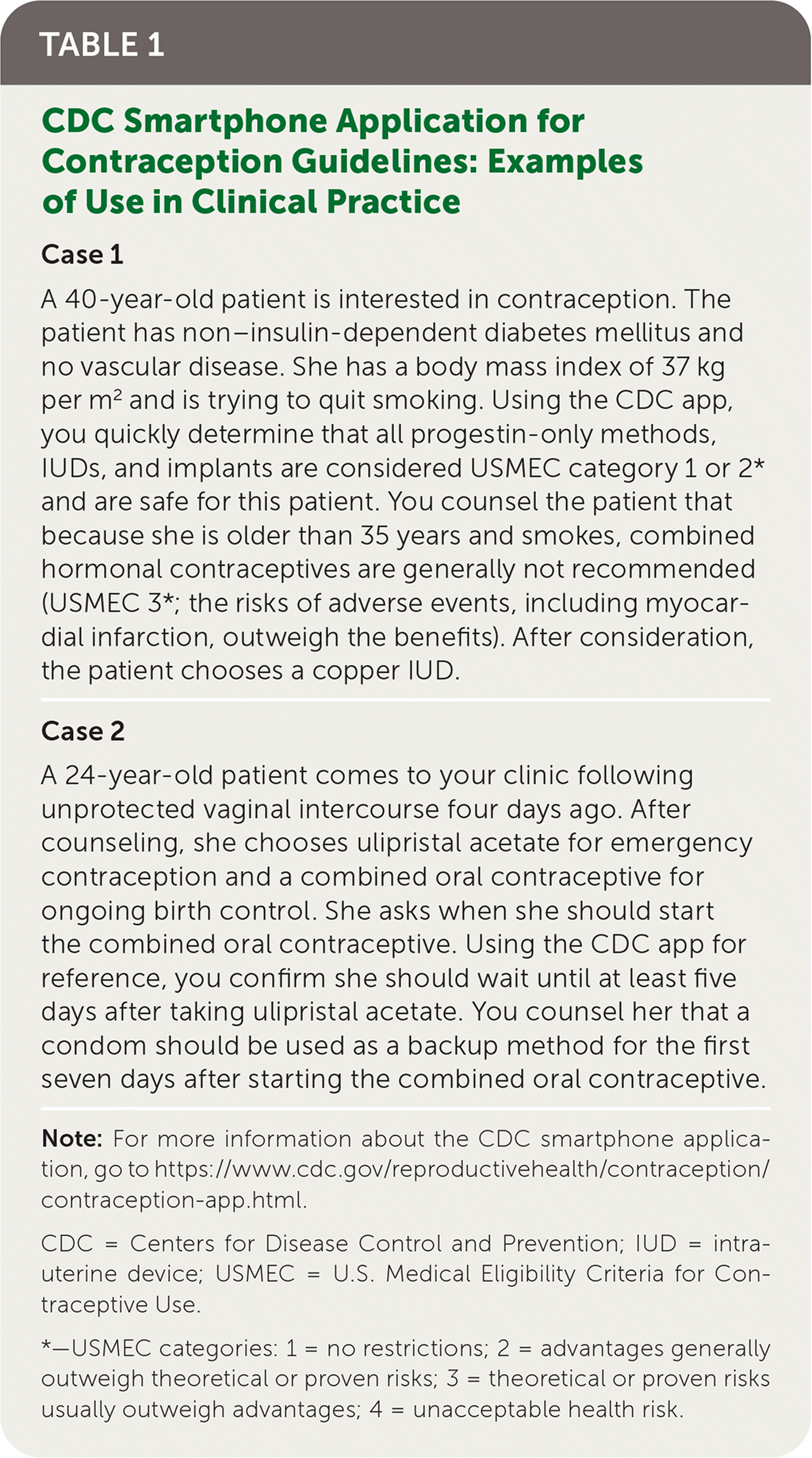
Am Fam Physician. 2022;106(3):227-228
Related article: Evidence-Based Contraception: Common Questions and Answers
Author disclosure: No relevant financial relationships.
Primary care clinicians are an important source of reproductive health care,1 but it can be challenging for busy clinicians to keep up with new developments. The U.S. Food and Drug Administration continues to approve new contraceptive methods, and knowledge of these changes is essential to informed patient-centered decision-making. One way for clinicians to stay up-to-date on new evidence regarding contraception safety and administration is to use point-of-care tools that summarize evidence-based recommendations. For example, the Centers for Disease Control and Prevention (CDC) has developed a free smartphone application (https://www.cdc.gov/reproductivehealth/contraception/contraception-app.html) that summarizes guidelines from the U.S. Medical Eligibility Criteria for Contraceptive Use (USMEC) and the U.S. Selected Practice Recommendations for Contraceptive Use (USSPR).2,3 These tools are easy to use and allow the clinician to incorporate evidence into counseling.
The CDC adapts guidance from the World Health Organization and publishes the USMEC and USSPR to provide clinicians with up-to-date, evidence-based contraception recommendations.2,3 The USMEC provides recommendations on contraceptive use for patients with medical conditions or other characteristics using a scale from 1 to 4. Category 1 indicates no restrictions for contraceptive use; category 2 indicates that advantages generally outweigh theoretical or proven risks; category 3 indicates that theoretical or proven risks usually outweigh advantages; and category 4 indicates an unacceptable health risk. The USSPR provides guidance for contraception provision, including how to assess pregnancy status before starting contraception, examinations and tests needed before starting a method, and management of side effects.
Two updates to CDC contraception recommendations have been recently published: recommendations regarding hormonal contraception for people at high risk of HIV and the self-administration of subcutaneous depot medroxyprogesterone acetate.4,5 In 2020, the CDC advised that all hormonal contraceptive methods and intrauterine devices (IUDs) are safe for use without restriction among people at high risk of HIV (USMEC category 1).4 This recommendation was based on results from a randomized controlled trial that randomized 7,800 women across four countries to one of three contraceptive methods (depot medroxyprogesterone acetate, levonorgestrel implant [not available in the United States], or copper IUD).6 The study found no statistically significant difference in HIV acquisition among groups.
In 2021, the CDC recommended self-administration of subcutaneous depot medroxyprogesterone acetate as an additional approach to deliver injectable contraception.5 This recommendation was based on a systematic review of six studies that found higher continuation rates if it was self-administered vs. administered by a clinician.7 Pregnancy rates and adverse events were similar between groups. Studies in the United States used brief instructional sessions with information from the subcutaneous depot medroxyprogesterone acetate label.5 Several organizations have developed implementation resources that may be helpful for people with limited access to a clinic or who want to minimize in-person clinic visits during the COVID-19 pandemic.5,8,9
To help busy clinicians easily access these recommendations, the CDC's smartphone application (available on iOS and Android platforms) enables users to view recommendations by choosing up to three patient characteristics or medical conditions simultaneously and includes a user tutorial. Users can quickly review practice recommendations for the patient's chosen contraceptive method, such as determining if a backup method is needed when switching to or starting a new contraceptive. Examples of clinical scenarios in which the application can assist a busy clinician are shown in Table 1. Additional tools, including summary charts of USMEC and USSPR recommendations and training and continuing education materials, are available at https://www.cdc.gov/reproductivehealth/contraception/contraception_guidance.htm.

| Case 1 |
| A 40-year-old patient is interested in contraception. The patient has non–insulin-dependent diabetes mellitus and no vascular disease. She has a body mass index of 37 kg per m2 and is trying to quit smoking. Using the CDC app, you quickly determine that all progestin-only methods, IUDs, and implants are considered USMEC category 1 or 2* and are safe for this patient. You counsel the patient that because she is older than 35 years and smokes, combined hormonal contraceptives are generally not recommended (USMEC 3*; the risks of adverse events, including myocardial infarction, outweigh the benefits). After consideration, the patient chooses a copper IUD. |
| Case 2 |
| A 24-year-old patient comes to your clinic following unprotected vaginal intercourse four days ago. After counseling, she chooses ulipristal acetate for emergency contraception and a combined oral contraceptive for ongoing birth control. She asks when she should start the combined oral contraceptive. Using the CDC app for reference, you confirm she should wait until at least five days after taking ulipristal acetate. You counsel her that a condom should be used as a backup method for the first seven days after starting the combined oral contraceptive. |
Accessibility, safety, and patient-centered care are defining elements of high-quality family planning.10 Use of evidence-based recommendations by primary care clinicians may reduce barriers and improve equitable access to contraception and prevent unnecessary medical restriction of contraceptive methods. For example, the USMEC recommendation regarding depot medroxyprogesterone acetate among patients at risk of HIV allows clinicians to prescribe any contraceptive method to this population.4 Similarly, the USSPR may help eliminate unnecessary medical barriers, such as the need for pelvic examinations for methods other than IUDs and diaphragms and an office visit for administration of depot medroxyprogesterone acetate.3,5 These resources equip clinicians with evidence-based knowledge to facilitate patient-centered decision-making regarding patients' reproductive goals.
The findings and conclusions in this report are those of the authors and do not necessarily represent the official position of the Centers for Disease Control and Prevention.
